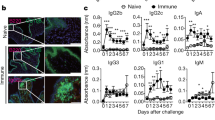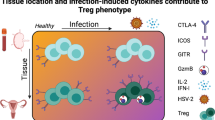Abstract
α4β7 integrin–expressing CD4+ T cells preferentially traffic to gut-associated lymphoid tissue (GALT) and have a key role in HIV and simian immunodeficiency virus (SIV) pathogenesis. We show here that the administration of an anti-α4β7 monoclonal antibody just prior to and during acute infection protects rhesus macaques from transmission following repeated low-dose intravaginal challenges with SIVmac251. In treated animals that became infected, the GALT was significantly protected from infection and CD4+ T cell numbers were maintained in both the blood and the GALT. Thus, targeting α4β7 reduces mucosal transmission of SIV in macaques.
This is a preview of subscription content, access via your institution
Access options
Subscribe to this journal
Receive 12 print issues and online access
$209.00 per year
only $17.42 per issue
Buy this article
- Purchase on Springer Link
- Instant access to full article PDF
Prices may be subject to local taxes which are calculated during checkout


Similar content being viewed by others
Accession codes
References
Brenchley, J.M. & Douek, D.C. Curr. Opin. HIV AIDS 3, 356–361 (2008).
Mehandru, S. et al. J. Exp. Med. 200, 761–770 (2004).
Veazey, R.S. et al. Science 280, 427–431 (1998).
Bargatze, R.F., Jutila, M.A. & Butcher, E.C. Immunity 3, 99–108 (1995).
Erle, D.J. et al. J. Immunol. 153, 517–528 (1994).
Arthos, J. et al. Nat. Immunol. 9, 301–309 (2008).
Nakamura, G.R., Fonseca, D.P., O'Rourke, S.M., Vollrath, A.L. & Berman, P.W. PLoS ONE 7, e39045 (2012).
Nawaz, F. et al. PLoS Pathog. 7, e1001301 (2011).
Pereira, L.E. et al. Cell. Immunol. 259, 165–176 (2009).
Ansari, A.A. et al. J. Immunol. 186, 1044–1059 (2011).
Kwa, S. et al. Blood 118, 2763–2773 (2011).
Kelly, K.A. & Rank, R.G. Infect. Immun. 65, 5198–5208 (1997).
Cicala, C. et al. Proc. Natl. Acad. Sci. USA 106, 20877–20882 (2009).
Kader, M. et al. Mucosal Immunol. 2, 439–449 (2009).
Martinelli, E. et al. J. Acquir. Immune Defic. Syndr. 64, 325–331 (2013).
McKinnon, L.R. et al. J. Immunol. 187, 6032–6042 (2011).
Feagan, B.G. et al. N. Engl. J. Med. 369, 699–710 (2013).
Jovani, M. & Danese, S. Curr. Drug Targets 14, 1433–1443 (2013).
Sandborn, W.J. et al. N. Engl. J. Med. 369, 711–721 (2013).
Danese, S. et al. Ann. Intern. Med. 160, 704–711 (2014).
Moreland, A.J. et al. BMC Genomics 12, 295 (2011).
O'Leary, C.E. et al. Immunogenetics 61, 689–701 (2009).
Lim, S.Y. et al. PLoS Pathog. 6, e1000738 (2010).
Nguyen, D.C., Scinicariello, F. & Attanasio, R. Immunogenetics 63, 351–362 (2011).
Butler, K. et al. AIDS Res. Hum. Retroviruses 29, 1091–1094 (2013).
Subbarao, S. et al. J. Med. Primatol. 36, 238–243 (2007).
Ansari, A.A. et al. J. Immunol. 186, 1044–1059 (2011).
Hudgens, M.G. & Gilbert, P.B. Biometrics 65, 1223–1232 (2009).
Regoes, R.R., Longini, I.M., Feinberg, M.B. & Staprans, S.I. PLoS Med. 2, e249 (2005).
Letvin, N.L. et al. J. Virol. 81, 12368–12374 (2007).
Promadej-Lanier, N. et al. J. Acquir. Immune Defic. Syndr. 53, 574–581 (2010).
Veazey, R.S., Shattock, R.J., Klasse, P.J. & Moore, J.P. Curr. HIV Res. 10, 79–87 (2012).
Spear, G., Rothaeulser, K., Fritts, L., Gillevet, P.M. & Miller, C.J. PLoS ONE 7, e52992 (2012).
McKinnon, L.R. et al. J. Immunol. 187, 6032–6042 (2011).
Pereira, L.E. et al. Cell. Immunol. 259, 165–176 (2009).
Arthos, J. et al. Nat. Immunol. 9, 301–309 (2008).
Acknowledgements
This work was supported by a grant from the NIH-NIAID AI-098628-01 (to A.A.A.), the NIAID NIH Intramural Research Program and OD 51POD1113 to the Yerkes National Primate Research Center. We are grateful to F. Connor-Stroud for help with the cytobrush studies and to the veterinary staff and animal caretakers of the Yerkes National Primate Center of Emory University, specially S. Ehnert and her team. The authors also acknowledge the assistance of M. Piatak for performing the ultrasensitive PCR analysis and R. Kaul and L.R. McKinnon for sharing with us their finding on cervical brush analyses in Africa and advising us on how to proceed in adapting their human findings to our nonhuman primates. Recombinant mAbs were produced by the Nonhuman Primate Reagent Resource (NIAID, NIH contract # HHSN272200900037C). The virus stock of SIVmac251 was obtained courtesy of N. Miller (NIAID, NIH). We apologize to all the authors whose publications we failed to cite. The findings in this report are those of the authors and do not necessarily reflect the views of the US Centers for Disease Control and Prevention.
Author information
Authors and Affiliations
Contributions
The day-to-day scheduling of the experiments were carried out under the laboratory supervision of A.E.M., technically performed by S.N.B., B.K., P.D., T.V. and D.L. The experiments described in Figure 2d–h were performed by F.N. and J.H. The overall planning and direction of the studies was carried out by A.A.A. C.C., F.V. and P.J.S. in regularly scheduled consultation with E.N.K., J.M.M. and T.G.P. D.H. provided the statistical planning of the studies and performed the statistical analyses of the data obtained. K.A.R. consulted and provided the large-scale preparation of the recombinant α4β7 monoclonal antibody and the normal rhesus IgG mAbs. M.B. and L.W. performed the major histocompatibility complex typing of the animals, and K.R. performed the Fc receptor typing of the animals. A.A.A. and T.G.P. prepared the draft of this manuscript with input from all the authors. A.S.F. provided helpful discussions and review and revision of the manuscript.
Corresponding author
Ethics declarations
Competing interests
The authors declare no competing financial interests.
Supplementary information
Supplementary Text and Figures
Supplementary Figures 1–5 and Supplementary Tables 1 and 2 (PDF 701 kb)
Rights and permissions
About this article
Cite this article
Byrareddy, S., Kallam, B., Arthos, J. et al. Targeting α4β7 integrin reduces mucosal transmission of simian immunodeficiency virus and protects gut-associated lymphoid tissue from infection. Nat Med 20, 1397–1400 (2014). https://doi.org/10.1038/nm.3715
Received:
Accepted:
Published:
Issue Date:
DOI: https://doi.org/10.1038/nm.3715
This article is cited by
-
RhCMV serostatus and vaccine adjuvant impact immunogenicity of RhCMV/SIV vaccines
Scientific Reports (2020)
-
Early treatment of SIV+ macaques with an α4β7 mAb alters virus distribution and preserves CD4+ T cells in later stages of infection
Mucosal Immunology (2018)
-
MAdCAM costimulation through Integrin-α4β7 promotes HIV replication
Mucosal Immunology (2018)
-
Common helical V1V2 conformations of HIV-1 Envelope expose the α4β7 binding site on intact virions
Nature Communications (2018)
-
Gut-homing α4β7 CD4+ T cells: potential key players in both acute HIV infection and HIV-associated cancers
Cellular & Molecular Immunology (2018)



